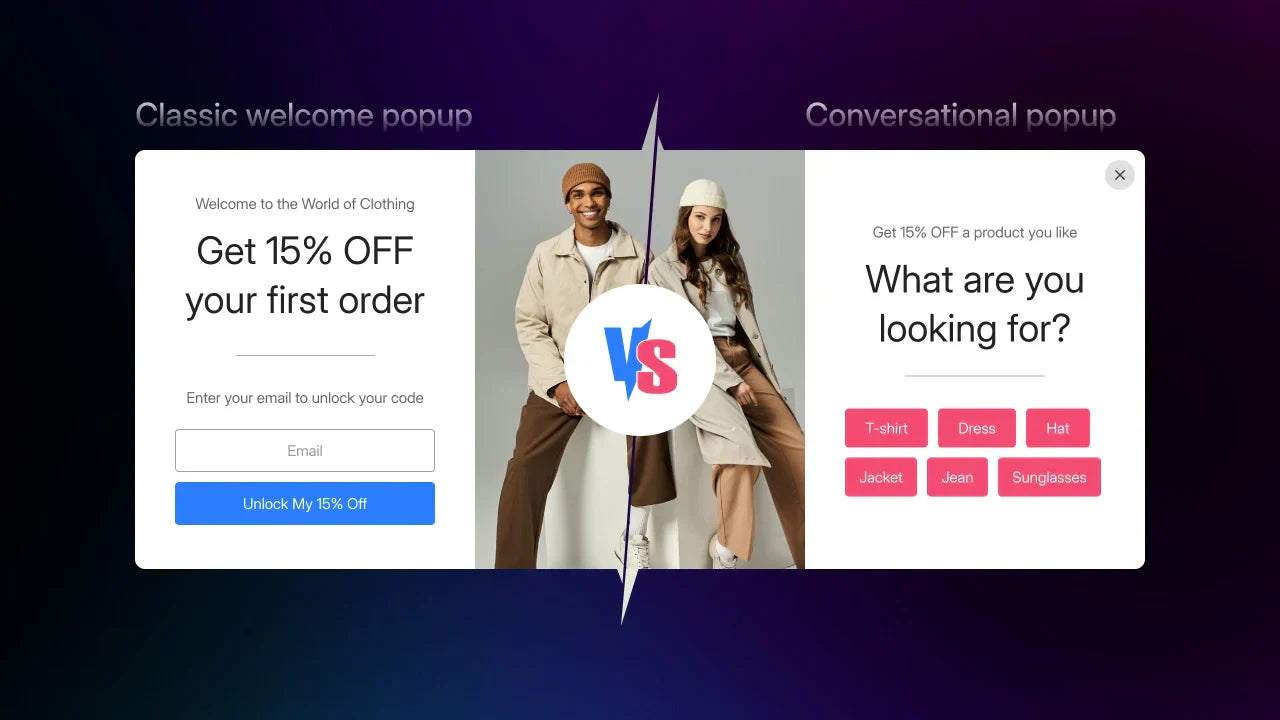Popups are one of the oldest, and most misunderstood tools in eCommerce. When used poorly, they interrupt and annoy. When used strategically, they capture intent, guide attention, and accelerate conversions.
The difference often comes down to tone.
This is where the idea of testing a classic welcome popup (the traditional “Get 10% off your first order” style) against a conversational popup (which mimics a friendly chat interaction) becomes powerful.
Both aim to collect emails and engage visitors, but the way they speak changes how users feel.
Using GemX, you can measure which style resonates better with your audience, uncover the psychological triggers behind each response, and iterate your approach based on data, not assumptions.
The Core Idea: From Interruption to Interaction
A popup’s job isn’t just to get an email address. It’s to make the first interaction with your brand meaningful.
Traditional popups are transactional — they offer something in exchange for data. Conversational popups are relational — they invite users into a short dialogue that feels human.
Let’s illustrate this with a simple example for an online pet food brand:
Classic popup:
“Join our newsletter and get 10% off your first order.”
[Email Field] [Get Discount]
Conversational popup:
“Hey there, pet parent! What’s your furry friend’s name?”
[Type answer → “Milo”]
“Nice! Milo deserves the best. Want 10% off his first meal?”
[Email Field] [Yes, send it!]
Both collect the same data. But the second one feels lighter, warmer, and personal. The tone builds trust and emotional engagement, reducing resistance to sharing information.
The hypothesis is simple:
If we replace a static, one-way popup with a conversational one that mirrors natural dialogue, the opt-in rate will increase, because users feel seen, not sold to.
The Psychology Behind Popup Style
Let’s unpack why conversational popups often outperform traditional ones, using behavioral insights applied in plain English.
1. Personalization Triggers Reciprocity
Humans instinctively respond to social cues, even from interfaces. When the popup “asks” something (like your pet’s name or skin type), it mimics real conversation. The brain registers this as social interaction, which triggers a subtle sense of reciprocity: you gave me attention, so I’ll give you something back (my email).
This doesn’t require advanced AI. A single conditional step (“choose your pet type → get relevant offer”) is enough to create perceived personalization.
2. Reducing Cognitive Load
Classic popups often throw information at users discount, email form, CTA all at once. A conversational popup stages the interaction step-by-step, which makes it cognitively easier to process.
Instead of “fill this out,” the user feels like they’re answering a question. This flow reduces friction and increases engagement, particularly on mobile devices where attention spans are shorter.
3. Emotional Framing and Tone
Language shapes emotion. A conversational popup uses friendly microcopy (“Hey there 👋,” “Want to treat yourself?”) that humanizes the brand. This tone activates approach behaviors, curiosity, warmth, and belonging rather than avoidance or resistance.
The classic popup, in contrast, often sounds purely transactional: “Subscribe for 10% off.” It works when the offer is strong, but lacks emotional color.
4. Perceived Control and Autonomy
Conversational flows give users the sense that they are driving the interaction. Each click feels like progress, not compliance. Behavioral design studies show that even minor interactions: selecting an answer, typing a short response can increase engagement because they give a feeling of autonomy.
In other words: the more users feel in control, the less they resist conversion.
Hypothesis and Experiment Design
|
IF we test a conversational-style welcome popup against a classic static one, THEN the email sign-up rate and first-purchase conversion rate will increase, BECAUSE a conversational tone fosters trust, lowers cognitive friction, and creates perceived personalization, making users more willing to engage. |
Case Study: Christopher Cloos — From Static Offer to Conversational Flow
A real-world example brings this home.
Christopher Cloos, a premium eyewear brand, tested two versions of their welcome popup:
-
Version A (Classic): A simple, static 10% discount popup.
-
Version B (Conversational): A chat-style popup asking, “Hey there 👋 Looking for your perfect pair? Get 10% off when you find your match.”
The conversational version invited visitors into a two-step interaction — first selecting a style preference, then entering their email.
Result: The conversational popup achieved a 15.38% higher conversion rate, proving that a small change in tone and interaction flow can meaningfully increase sign-ups and sales.

(Case study from Optimonk)
This test didn’t rely on gimmicks or gamification. It simply made the exchange feel more personal, and that was enough to shift behavior.
Setting It Up in GemX: Step-by-Step
Step 1: Select Control Template
Start by identifying the page or template that currently contains your classic welcome popup, your existing “10% off” or “Join our newsletter” version.
This serves as Version A (Control), the baseline experience.
In GemX, go to Create New Experiment → Template Testing, and set your control template to the current version.

Step 2: Create Variant Template
Now, create Version B (Variant), the conversational popup version.
If you’re using GemPages, simply click “Create Variant based on Control.”

GemX will automatically duplicate your control template, keeping the rest of the page identical.
Then, open the GemPages Editor and adjust only the popup element:
-
Replace static copy with a short dialogue flow.
-
Keep the offer identical (e.g., “10% off”).
-
Add one light question (like “What’s your pet’s name?” or “What are you shopping for today?”).

If you use another builder, prepare both templates beforehand, then select them from your store inside GemX.
Tip: Keep every other variable constant, same visuals, timing, trigger behavior (e.g., after 5 seconds or on exit intent), and placement. This ensures you’re testing only the popup style, not multiple changes.
Step 3: Configure Advanced Experiment Settings
GemX lets you define how your experiment distributes traffic, measures outcomes, and isolates variables.
Let’s break down the recommended setup for this use case:
1. Winning Metric
Recommended: Conversion
Why: The goal of this experiment is to measure email opt-ins or first-purchase rate uplift, not immediate revenue. Conversational popups improve lead acquisition and engagement more than direct cart size. Once validated, you can test revenue impact later.

2. Device Targeting
Recommended: All devices
Why: Popups behave differently across screens, but conversational flows tend to perform especially well on mobile due to simplicity and touch-friendly design. Testing across all ensures you capture holistic insights and later segment by device for deeper analysis.

3. Visitor Type
Recommended: New visitors
Why: The welcome popup is primarily a first-touch tool. Returning visitors may already be subscribed or immune to entry popups. Focusing on new visitors isolates first-impression behavior, making results cleaner and more actionable.

4. Traffic Source
Recommended: Organic Search or Paid Social
Why: These channels often bring top-of-funnel visitors — people discovering your brand for the first time. They’re less familiar and more responsive to conversational tone. Paid traffic also has a clearer ROI metric (cost per signup or cost per lead).
Avoid including email or returning user traffic; these segments have already interacted with your brand.

5. Traffic Split
Recommended: 50/50 Split
Why: Keeping the distribution even ensures statistical balance. GemX automatically manages this and reports significance levels as data accumulates.

6. Market & Language
Recommended: Target your top-performing market first.
Why: Cultural tone and conversational style vary. A friendly chat-style popup may outperform in the U.S. but underperform in markets where users prefer concise, professional tones. Testing one market at a time isolates tone effects without cultural bias.

Step 4: Launch and Monitor
Once your experiment is set up, GemX will automatically start splitting traffic between the two versions, tracking metrics like:
-
Email signup rate
-
Bounce rate
-
Conversion-to-first-purchase
You’ll see real-time insights and confidence levels in the GemX dashboard.
Interpreting Results
When your test reaches statistical significance, go beyond surface-level metrics.
Look for Segment-Level Behavior
For example:
-
Mobile users may engage more with conversational popups.
-
Desktop users might prefer clarity and simplicity.
-
Paid visitors may be more responsive to friendliness; organic ones may prefer direct value.
These nuances guide future personalization.
Analyze Conversion Quality
Check if the additional signups from conversational popups also convert to purchases at a healthy rate. More leads aren’t always better if they don’t buy later — GemX’s built-in metrics help track this downstream impact.
Behavioral Insight
Map the winning version to its underlying driver:
-
Emotional connection?
-
Clarity and control?
-
Ease of input?
Once you understand why it worked, you can apply that learning to other touchpoints — like checkout flows, chat widgets, or upsell popups.
Why GemX Is Perfect for Popup Testing
Running popup experiments used to be a hassle. You’d have to clone pages manually, edit variants in another builder, add tracking scripts, and wait weeks for meaningful results. GemX simplifies all of that — it’s built to work seamlessly with GemPages and Shopify, so you can design, launch, and learn from every test inside one visual workspace.
Here’s why it’s the best choice for popup A/B testing:
Deep Integration with GemPages
GemX is natively integrated with GemPages, so you can:
-
Duplicate and edit templates instantly: just click “Create Variant Based on Control” and open the GemPages Editor directly.
-
Customize the popup variant visually: change the tone, question flow, or design right inside the GemPages canvas, no code or extra tools required.
-
Maintain perfect design consistency: because both versions share the same layout structure, you’re isolating just the popup for a clean, reliable test.
This tight integration means you can go from idea to live A/B test in minutes — not hours.
Real-Time, Visual Analytics
Once your experiment is live, GemX tracks performance data in real time — no more waiting for spreadsheets or external analytics.
Inside your GemX dashboard, you can:
-
Monitor live conversion rates, signup volume, and statistical confidence.
-
View traffic distribution and sample size per variant to ensure balanced exposure.
-
See trends at a glance with clear charts and color-coded progress indicators.
Every data point updates automatically as users interact with your site, giving you immediate visibility into which popup style is resonating best.
Actionable Insights for Every Test
After your popup test concludes, GemX’s analytics dashboard lets you dig deeper:
-
Compare conversion rates, bounce rates, and opt-in completion side by side.
-
Track how each version influences downstream revenue or post-signup purchases.
-
Export insights directly to share with your marketing or design team.
Designed for Continuous Optimization
GemX encourages iteration. Once a winning popup is identified, you can:
-
Duplicate it as the new control.
-
Test another variable: tone, timing, trigger, or incentive, in the next round.
-
Build a library of tested ideas, turning experiments into a scalable CRO workflow.
Each experiment compounds your understanding of what converts, helping your store evolve from guesswork to growth.











